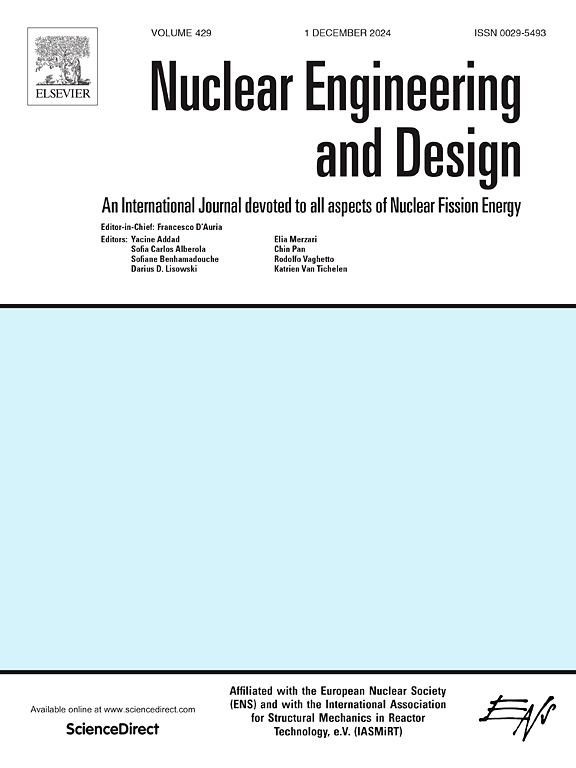Innovative thorium-based fuel assemblies for LW-SMR: In-depth assembly-level neutronic analysis and safety considerations in solid and annular configurations
IF 2.1
3区 工程技术
Q1 NUCLEAR SCIENCE & TECHNOLOGY
引用次数: 0
Abstract
This study presents a comprehensive neutronic and safety evaluation of different thorium-based fuel compositions (Th-235U)O2, (Th-233U)O2, and a new proposed composition, namely, (Th-233U-235U)O2 fuel, compared to conventional UO2 in solid and dual-cooled annular assembly configurations in the context of Small Modular Reactors (SMR) applications. Results demonstrate that (Th-233U)O2 achieves the highest cycle length in both solid configurations, significantly exceeding UO2 performance. The proposed, however, (Th-233U-235U)O2 composition exhibits favorable safety characteristics, including enhanced negative temperature reactivity coefficients and favorable kinetic parameters. Annular fuel configurations also demonstrate superior thermal performance with centerline temperature reductions of approximately 50 °C compared to solid configurations and consistently lower power peaking factors throughout burnup. The findings indicate that thorium-based fuels, particularly (Th-233U-235U)O2 in dual-cooled annular configuration, offer compelling advantages for SMR applications, including extended fuel cycles, improved safety characteristics, enhanced proliferation resistance, and superior thermal performance, supporting their viability as sustainable alternatives to conventional uranium-based fuels.
用于LW-SMR的创新钍基燃料组件:在固体和环空配置中进行深入的组件级中子分析和安全考虑
本研究对不同钍基燃料成分(Th-235U)O2、(Th-233U)O2和一种新提出的成分(Th-233U- 235u)O2燃料进行了全面的中子和安全性评估,并在小型模块化反应堆(SMR)应用的背景下,将固体和双冷环形组件配置中的传统UO2进行了比较。结果表明,(Th-233U)O2在两种固体构型下的循环长度最高,显著超过UO2的性能。然而,所提出的(Th-233U-235U)O2组分具有良好的安全特性,包括增强的负温度反应性系数和有利的动力学参数。与固体燃料相比,环形燃料结构也表现出卓越的热性能,其中心线温度降低了约50°C,并且在整个燃耗过程中始终保持较低的功率峰值系数。研究结果表明,钍基燃料,特别是双冷环形结构中的(Th-233U-235U)O2,为SMR应用提供了令人信服的优势,包括延长燃料循环,改善安全特性,增强抗核扩散能力和优越的热性能,支持其作为传统铀基燃料的可持续替代品的可行性。
本文章由计算机程序翻译,如有差异,请以英文原文为准。
求助全文
约1分钟内获得全文
求助全文
来源期刊

Nuclear Engineering and Design
工程技术-核科学技术
CiteScore
3.40
自引率
11.80%
发文量
377
审稿时长
5 months
期刊介绍:
Nuclear Engineering and Design covers the wide range of disciplines involved in the engineering, design, safety and construction of nuclear fission reactors. The Editors welcome papers both on applied and innovative aspects and developments in nuclear science and technology.
Fundamentals of Reactor Design include:
• Thermal-Hydraulics and Core Physics
• Safety Analysis, Risk Assessment (PSA)
• Structural and Mechanical Engineering
• Materials Science
• Fuel Behavior and Design
• Structural Plant Design
• Engineering of Reactor Components
• Experiments
Aspects beyond fundamentals of Reactor Design covered:
• Accident Mitigation Measures
• Reactor Control Systems
• Licensing Issues
• Safeguard Engineering
• Economy of Plants
• Reprocessing / Waste Disposal
• Applications of Nuclear Energy
• Maintenance
• Decommissioning
Papers on new reactor ideas and developments (Generation IV reactors) such as inherently safe modular HTRs, High Performance LWRs/HWRs and LMFBs/GFR will be considered; Actinide Burners, Accelerator Driven Systems, Energy Amplifiers and other special designs of power and research reactors and their applications are also encouraged.
 求助内容:
求助内容: 应助结果提醒方式:
应助结果提醒方式:


